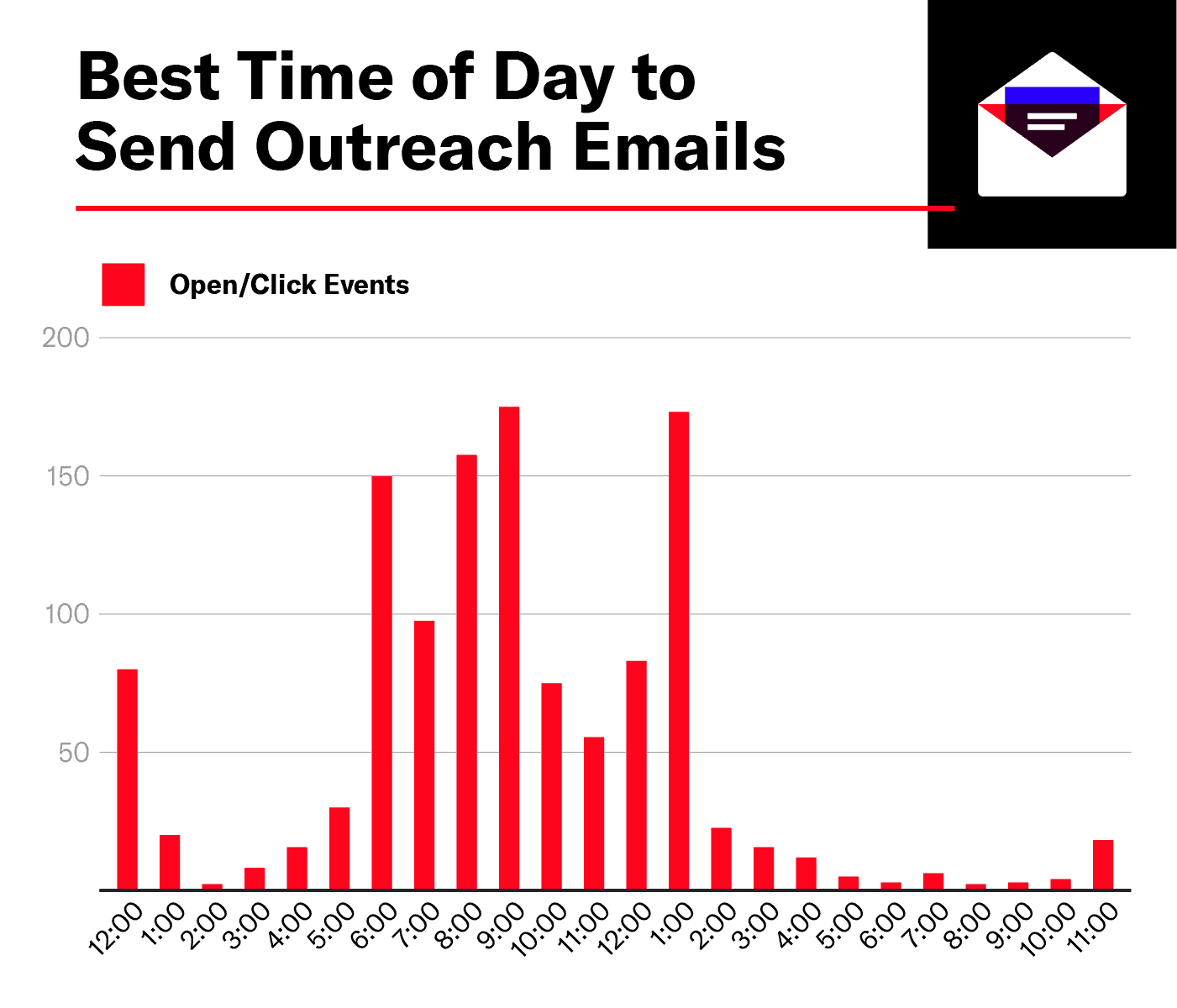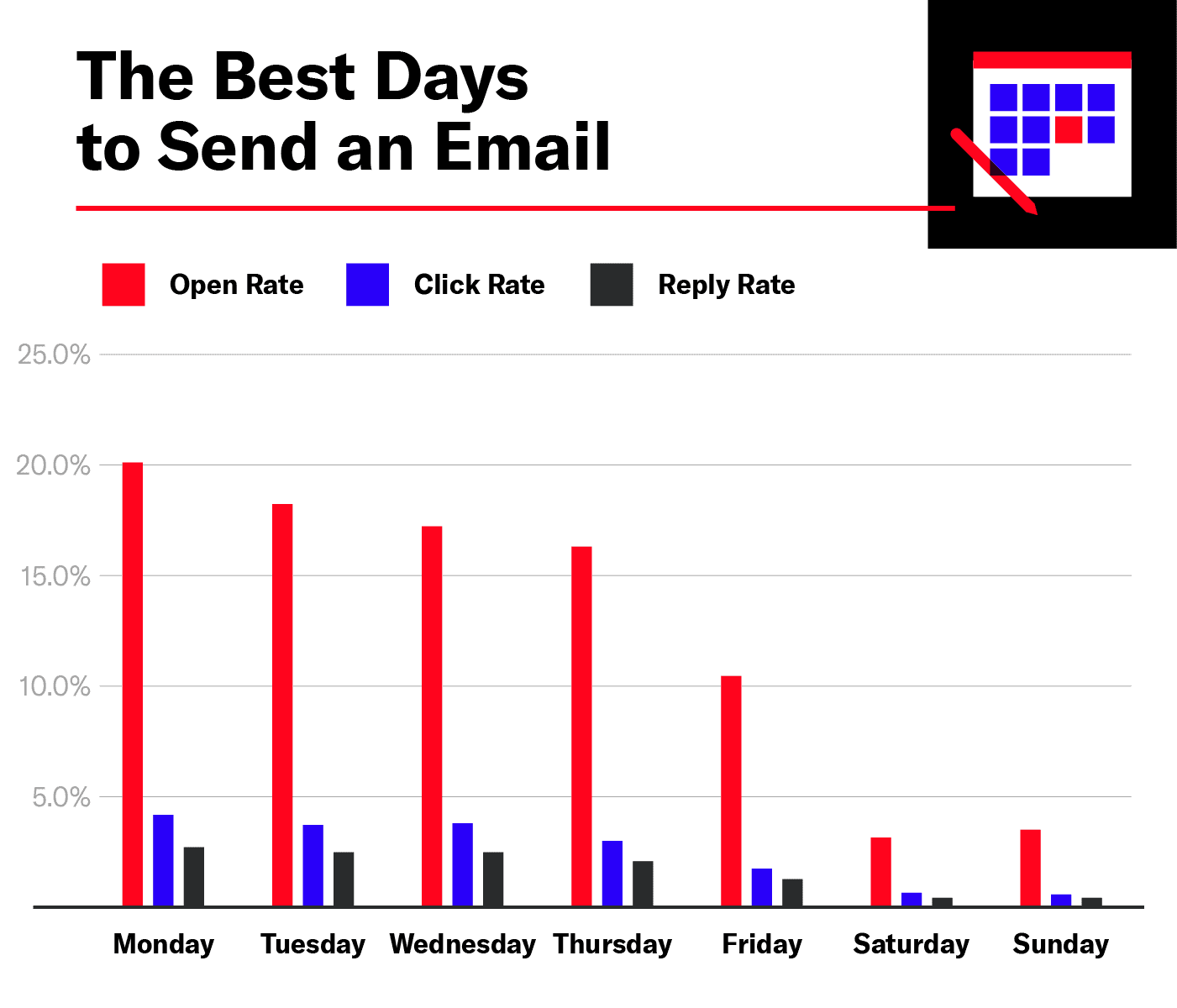Our research of over 85,000 personalized emails shows that the best time to send cold emails is between 6-9am PST on Monday, with Tuesday as a close second.
Although we’ve shifted our strategy to less manual link building, our content marketing team has sent over 1 million personalized cold emails, and that number has made us quite the expert over time.
You could even say we know how to siege the attention of a few people with emails sent at just the right time. And sometimes, one email simply isn’t enough — people are practically begging for a follow-up email.
We decided to analyze Buzzstream data from our team’s efforts to determine when is actually the best time to send an email — but wait, there’s more — we also analyzed the best day of the week to send an email and you can check out my colleague Sierra’s post for a bonus study on our subject lines.
Disclaimer: The data represented in this study is entirely based on personalized emails and not newsletters or bulk cold email blasts. You could call these “room-temperature emails” or “goldie-locks emails,” because they aren’t exactly warm emails but they’re not exactly cold.
Best Time to Send Cold Email
When analyzing email open and click event data from our outreach emails, we’ve discovered that the best time of day to send cold emails is between 6-9 am PST (9 am-12 pm EST).
We found it interesting that some other studies determined 10 am was the best time to send emails. Strangely, however, 10 am in our data saw significant declines in open and click rates for both 10 am PST and 10 am EST. We had the thought that as people get into their workday, they start with the more important and personalized emails first, and then around 10 am clear out their newsletters and bulk emails.
If you want your email to be delivered at the optimal time, we recommend scheduling delivery between 7-8 am PST to take advantage of the two-hour spike in open and click rates experienced between 8-10 am.
What Is The Best Day to Send Email?
According to our data, the best day to send email is Monday with an open rate of just over 20 percent, a click rate of 4.3 percent and a reply rate of 2.8 percent.
Our study found that as the week goes on, recipients are less likely to open, click or reply to your email. This could be the nature of our email campaigns, most often a reporter, blogger or content manager, who may be more receptive to pitches earlier in the week. This is why our team largely front loads emails earlier in the week.
Wednesday is a great day to send emails if the reply-rate is your most important metric. Although the open rate is slightly lower than Monday, at 17.2 percent, the reply rate is 2.6 percent, only 0.3 percent less than Monday.
Best Time and Day To Send Email
After analyzing the performance of our team’s highly personalized outreach emails, we’ve determined the best time to send is Monday between 6-9 am PST.
If you’re reading this post because it was featured in our newsletter, go back and check what day/time it was delivered, if it wasn’t Monday between 6-9 am PST, please don’t reply to that email to prove a point for me. 🙂
How Our Study Compares
To level the playing field and give you the most comprehensive answer possible, we decided to peek at the answers of our fellow students (ie. the other popular studies on the subject). We didn’t cheat, we just peeked!
Out of the nine other studies we looked at, 55% said Tuesday is the best day to send email with the remaining 45% equally distributed between Wednesday and Thursday.
So as you can see, not many people agree with our results, which is why we think the answer is more complicated than Monday between 6-9 am. This isn’t the Hitchhiker’s Guide to the Email Galaxy and the answer is not 42.
Your results will depend heavily on what type of email you are sending (promotional, transactional, etc.) and how you’ve acquired your email addresses (purchased list, subscribers or discovered during outreach).
This is why we advocate you take a data-driven approach to your own outreach efforts and determine what works best for you and your team. We will provide a few tips for becoming more data-driven in your email efforts.
Analyzing Your Email Campaign Performance
1. Track Open, Click and Reply Rates
We mentioned our team uses Buzzstream, which is a tool heavily tailored to pitching journalists and other forms of PR/outreach. If you are sending marketing emails, there are a number of tools available to service this need, such as MailChimp, SendGrid or ConvertKit.
Gmail doesn’t let you do much in the way of analyzing your email data, however there are some extensions that can help to this end as well, most notably, EmailMeter and MixMax. One of our favorite email finder tools, Hunter, also recently launched an email tracking tool!
2. Track Email Traffic in Google Analytics
One of the unfortunate things about the traffic you drive from newsletters and outreach emails is that Google Analytics will classify this traffic as medium “(none)” and source “(direct),” which aren’t very descriptive or informative.
If you want to more clearly measure how the traffic from your emails navigate your site, you can create a UTM tracking URL to use within the CTAs of your emails. Use this campaign URL builder tool to create and track your attribution funnels more closely from email.
3. Always A/B/C Test Your Campaigns
You’re probably aware of A/B testing, or splitting your list into two segments that receive different emails to test which performs better, but you’ve probably never heard of A/B/C testing.
Traditional split testing lacks a control group (the “C” is for control) to truly measure improved performance. This is why you should have a very standard email template that is used consistently and has established a baseline performance in regards to open, click and reply rate. That will be your control group. From there, you can introduce slight modifications in the form of your A and B templates.
Emphasis on slight. You should look to introduce minor changes slowly to avoid erratic moves away from the benchmark email which won’t help you determine what modifications led to any improvements or declines in performance.
4. Open vs. Click-Through vs. Reply Rate
Want to know if your subject lines are intriguing your recipients? Open rate is the proxy you should use for this statistic. When someone opens your email, there are only a few things that could have caused them to open: the subject line, excerpt and sender’s name. This is why your open rates can be a lagging indicator of subject line performance to help refine your strategy.
Click-through rate is a good indicator for how engaging your actual email copy was, leading the recipient to click on the link. Reply rate is not as relevant among bulk email and newsletter marketers but it’s the high-and-almighty-metric for sales and PR teams. Reply rates are great for determining how clear your call to actions are and how receptive your audience is to your pitches.
5. Analyze Monthly, Quarterly and Annually
Perhaps your team has analyzed the performance of your email campaigns in the past, but are you measuring performance on a regular basis? Once is better than never, but it’s hard to truly understand how your emails are performing and improving without a regular analytics cadence.
We are definitely guilty of resting on our laurels as a team of outreach specialists. We are confident in our ability to send personalized emails that result in links, but after conducting this study, we plan to continue this analysis at least once per quarter, run our A/B/C tests and recalibrate the following quarter.
Methodology
We analyzed 85,082 outreach emails our team sent over a 12-month period. We looked at the number of emails sent, opened, clicked and replied for each day and then combined results for each corresponding day of the week.
We normalized the data by looking at open, click and reply rates for each day of the week compared to the total number for the entire year. Otherwise, Saturday and Sunday would appear to be the best day to send emails, but we all know that is farcical at best.
For the best time to send an email, we looked at the time stamp when emails were opened and clicked based on data provided by Buzzstream, a tool our team uses to track outreach campaigns.






